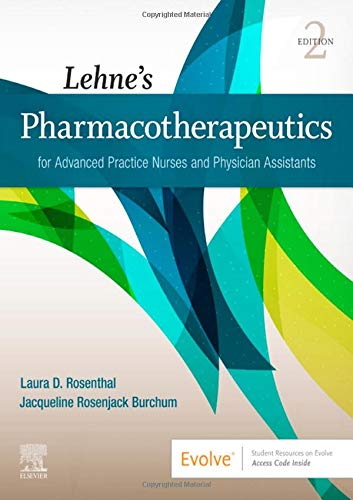Lehne’s Pharmacotherapeutics for Advanced Practice Nurses and Physician Assistants 2nd Ed. Test Bank
Digital item No Waiting Time Instant DownloadChapters: 92Format: PDFISBN-13: 978-0323554954ISBN-10: 0323554954Publisher: SaundersAuthors: Laura Rosentha, Jacqueline Burchum
In Stock
Original price was: $55.00.$24.00Current price is: $24.00.
Lehne’s Pharmacotherapeutics for Advanced Practice Nurses and Physician Assistants 2nd Ed. Test Bank
Lehne’s Pharmacotherapeutics for Advanced Practice Nurses and Physician Assistants, 2nd Edition – Test Bank
Lehne’s Pharmacotherapeutics for Advanced Practice Nurses and Physician Assistants, 2nd Edition is a comprehensive resource designed to provide advanced practice nurses (APNs) and physician assistants (PAs) with essential knowledge in pharmacology. The accompanying test bank for this edition is a crucial tool that supports both educators and students in assessing their understanding of pharmacotherapeutic principles and clinical applications.
Overview
Purpose and Utility
- Exam Preparation: The test bank is a valuable resource for students preparing for certification exams and coursework assessments. It provides a wide range of question types that mimic the style and complexity of real exams.
- Knowledge Consolidation: It helps students reinforce and test their understanding of key pharmacotherapeutic concepts covered in the textbook.
- Teaching Resource: Educators can utilize the test bank to create customized quizzes, exams, and assignments that align with their curriculum objectives.
Key Features
Content Alignment
- Chapter-by-Chapter Organization: The test bank is meticulously organized to align with the chapters of the textbook, ensuring that each topic is thoroughly covered.
- Comprehensive Coverage: It includes questions on a wide array of pharmacotherapeutic topics, including drug mechanisms, therapeutic uses, adverse effects, and considerations for special populations.
Question Types
- Multiple-Choice Questions (MCQs): Designed to test a broad range of knowledge, from basic pharmacology principles to complex clinical decision-making.
- True/False Questions: Help assess students’ understanding of fundamental concepts and facts in pharmacology.
- Short-Answer Questions: Require students to provide more detailed responses, demonstrating a deeper understanding of specific topics.
- Case-Based Questions: Present clinical scenarios that require students to apply their knowledge in practical settings, enhancing their critical thinking and problem-solving abilities.
Answer Explanations
- Detailed Rationales: Each question is accompanied by a rationale that explains why the correct answer is correct and why the other options are incorrect.
- Clinical Insights: The rationales often include additional clinical information to help students understand the real-world application of pharmacotherapeutic principles.
Key Topics Covered
Pharmacokinetics and Pharmacodynamics
- Absorption, Distribution, Metabolism, and Excretion: Questions on how drugs are processed in the body.
- Drug-Receptor Interactions: Understanding the molecular basis of drug action and its effects on the body.
- Dose-Response Relationships: Concepts related to drug potency, efficacy, and therapeutic index.
Therapeutic Applications
- Drug Therapy for Common Conditions: Including hypertension, diabetes, asthma, infectious diseases, and more.
- Special Populations: Pharmacotherapy considerations for pediatric, geriatric, and pregnant patients.
- Adverse Drug Reactions: Identification and management of side effects, drug interactions, and contraindications.
Clinical Decision-Making
- Patient Assessment: Evaluating patient history, symptoms, and diagnostic findings to make informed pharmacotherapeutic decisions.
- Drug Selection: Criteria for choosing the most appropriate drug therapy based on efficacy, safety, and patient-specific factors.
- Monitoring and Follow-Up: Strategies for monitoring therapeutic outcomes and adjusting therapy as needed.
Ethical and Legal Considerations
- Prescribing Practices: Understanding the ethical and legal responsibilities associated with prescribing medications.
- Informed Consent: Ensuring patients are informed about the benefits, risks, and alternatives to drug therapy.
- Drug Regulation and Approval: Familiarity with the regulatory processes governing drug development and approval.
Benefits of the Test Bank
For Students and Practitioners
Comprehensive Review
- Extensive Practice: The wide range of questions allows for thorough practice and reinforcement of pharmacotherapeutic knowledge.
- Focused Study: Students can target specific areas of difficulty or interest to enhance their understanding.
Effective Exam Preparation
- Realistic Practice: The questions simulate the format and content of certification exams and classroom assessments, helping students prepare effectively.
- Detailed Feedback: Answer rationales provide valuable insights that help students understand their mistakes and learn from them.
For Educators
Versatile Teaching Tool
- Customizable Assessments: Educators can create quizzes, exams, and assignments tailored to their course objectives using the test bank.
- Student Evaluation: The test bank allows for the accurate assessment of student knowledge and the identification of areas needing further instruction.
Enhanced Learning Outcomes
- Interactive Learning: The variety of question types encourages active learning and critical thinking among students.
- Knowledge Application: Case-based questions help students apply theoretical knowledge to clinical scenarios, preparing them for real-world practice.
Practical Applications
Individual Study
- Self-Assessment: Students can use the test bank for self-assessment to gauge their understanding and readiness for exams.
- Targeted Review: Focused practice on challenging areas helps solidify knowledge and improve exam performance.
Group Study
- Collaborative Learning: Group study sessions can benefit from the test bank’s diverse question formats, fostering discussion and deeper understanding.
- Peer Teaching: Students can quiz each other and explain rationales, reinforcing their own knowledge in the process.
Classroom Integration
- Quizzes and Exams: Educators can use the test bank to create formative and summative assessments that align with course objectives.
- Interactive Discussions: Case-based questions can serve as the basis for in-class discussions, encouraging students to think critically about pharmacotherapy.
Conclusion
The Test Bank for Lehne’s Pharmacotherapeutics for Advanced Practice Nurses and Physician Assistants, 2nd Edition is an invaluable resource for both students and educators in the field of advanced pharmacology. It provides a comprehensive array of questions that cover key pharmacotherapeutic concepts, clinical decision-making, and ethical considerations, making it an essential tool for mastering the material and excelling in both academic and professional settings. Whether used for individual study, group work, or classroom assessments, this test bank enhances learning outcomes and prepares students for success in their pharmacology courses and beyond.


Reviews
There are no reviews yet.